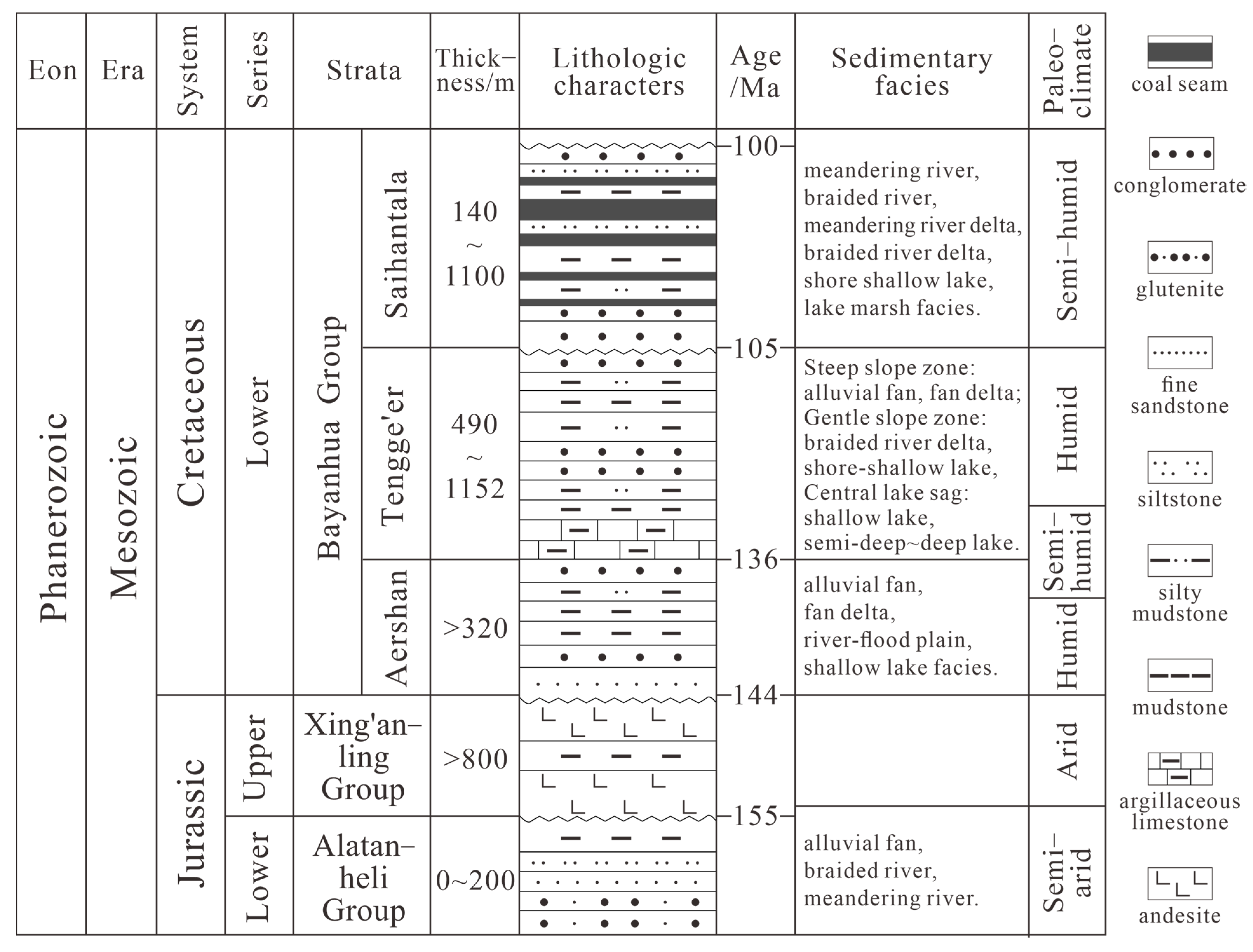Geochemical Characteristics and Hydrocarbon Generation Potential of Source Rock in the Baorao Trough, Jiergalangtu Sag, Erlian Basin
Abstract
1. Introduction
2. Geological Setting
3. Samples and Methods
3.1. Samples
3.2. Methods
4. Results
4.1. Bulk Organic Geochemical Characterization
4.1.1. Geochemical Parameters of Whole Rock
4.1.2. Geochemical Parameters of Kerogen
4.2. Vitrinite Reflectance Characterization
4.3. Molecular Geochemical Characteristics
4.3.1. N-Alkanes and Isoprenoids
4.3.2. Terpenoids
4.3.3. Steroids
5. Discussion
5.1. Hydrocarbon Generation Potential
5.1.1. Organic Matter Abundance
5.1.2. Organic Matter Type
5.1.3. Thermal Maturity
5.2. Geochemical Characteristics
5.2.1. Organic Matter Sources
5.2.2. Sedimentary Environment
5.3. Hydrocarbon Generation and Expulsion Characteristics
6. Conclusions
Author Contributions
Funding
Data Availability Statement
Conflicts of Interest
References
- Momper, J.A. Oil migration limitations suggested bygeological and geochemical considerations. AAPG Bull. 1978, 62, 545. [Google Scholar]
- Hunt, J.M. Petroleum Geochemistry and Geology; Free Man and Company: San Franciso, CA, USA, 1979; p. 524. [Google Scholar]
- Li, H.W.; Qi, Q.H.; Han, F.; Zhang, P.B.; Nie, Z.K.; Guan, X.Q. Analysis of Low-rank Coal Distribution and Coalbed Methane Enrichment Rules in Erlian Basin. China Coalbed Methane 2019, 16, 19–23, (In Chinese with English Abstract). [Google Scholar]
- Xiang, X.; Huang, C.Y.; Cao, L.Z.; Cao, Q.; Jiang, T.; Zhang, Y.F.; Song, Y.; Xu, J. Enrichment model and exploration potential for unconventional oi land gas in troughs, Erlian Basin. Earth Sci. Front. 2023, 30, 462–472, (In Chinese with English Abstract). [Google Scholar] [CrossRef]
- Wang, J.; Wang, Q.; Zhong, X.M.; Dong, X.Y.; Ma, X.F.; Sui, L.M. Characteristics of high-quality hydrocarbon source rocks and their contributions to reservoirs in the Erlian Basin. Pet. Geol. Exp. 2015, 37, 641–647, (In Chinese with English Abstract). [Google Scholar] [CrossRef]
- Wu, Z.Q. Source Rock and Petroleum Accumulation in Jiergalangtu Sag, Erlia Basin. Master’s Thesis, China University of Petroleum, Beijing, China, 2019. (In Chinese with English Abstract). [Google Scholar] [CrossRef]
- Yi, D.H.; Jia, Y.R.; Lei, M.; Shi, L.T. Analysis of hydrocarbon reservoir characteristics and its key control factors in Baorao trough, jiergalangtu sag. Xinjiang Oil Gas 2006, 2, 15–18+98, (In Chinese with English Abstract). [Google Scholar]
- Shi, L.T. Erlian Subtle Reservoir Studies and Reservoir DescriptionStudy on Subtle Reservoirs in Jiergalangtu Sag, Erlian Basin. Ph.D. Thesis, Chengdu University of Technology, Chengdu, China, 2012. (In Chinese with English Abstract). [Google Scholar]
- Wang, S.X.; Zhang, Z.H.; Zhang, Z.P.; Wang, Q.L. Geochemical Characteristics and Oil-source Correlation of the Jurassic Source Rocks in the Erlian Basin. Bull. Mineral. Petrol. Geochem. 2012, 31, 396–403, (In Chinese with English Abstract). [Google Scholar]
- Ding, X.J.; Liu, G.D.; Zhao, L.M.; Gao, D.K.; Zhang, K.; Kuang, D.Q. Organic Matter Enrichment and Hydrocarbon Source Rock Forming Mechanism in Small—Scale Faulted Lacustrine Basins: A Case from the First Member of Lower Cretaceous Tenger Formation in Erlian Basin. Xinjiang Pet. Geol. 2017, 38, 650–657, (In Chinese with English Abstract). [Google Scholar] [CrossRef]
- Yan, W.H.; Zhang, W.F.; Zhang, L.X.; Chen, Y.N. Integrative geologic evaluation and objective optimization of Saihantala sag, Erlian basin. Oil Geophys. Prospect. 2008, 139–145+196+12–13, (In Chinese with English Abstract). [Google Scholar] [CrossRef]
- Zhao, X.Z.; Jin, F.M.; Qi, J.F.; Wang, Q.; Yang, M.H.; Shi, Y.P.; Dong, X.Y. The Structural Types and Petroleum Geological Significance of Early Cretaceous Complex Faulted Sag in Erlian Basin. Nat. Gas Geosci. 2015, 26, 1289–1298, (In Chinese with English Abstract). [Google Scholar] [CrossRef]
- Zhu, Y.H.; Zhang, W.C. Type of stratigraphic sequence in Erlian basin and its significance in oil/gas exploration. Pet. Explor. Dev. 1999, 26, 49–53+5, (In Chinese with English Abstract). [Google Scholar]
- Jiao, G.H.; Wang, T.H.; Xing, H.S. Evolution of Rift Valley Structure and Oil-Gas in Erlian Basin; Petroleum Industry Press: Beijing, China, 2003. (In Chinese) [Google Scholar]
- Jiang, S.Q.; Si, J.W.; Zhao, A.J.; Wu, J.P.; Shen, J.S. Exploration of lithologic Oi Reservoirs in Jiergalangtu Depression of Erlian Basin. China Pet. Explor. 2004, 3, 46–53+7, (In Chinese with English Abstract). [Google Scholar]
- Sun, J.M.; Pang, X.Q.; Shen, J.S.; Liang, F.; Lang, J. Non-Structural Reservoir Exploration in Jiergalangtu Sag, Erlian Basin. Xinjiang Pet. Geol. 2005, 26, 380–382, (In Chinese with English Abstract). [Google Scholar]
- Fei, B.S. Petroleum Exploration of Rift Basin Group in Area of Northeast Asia, Shown by the Erlian Basin. Pet. Geol. Oilfield Dev. Daqing 2002, 21, 7–11+81, (In Chinese with English Abstract). [Google Scholar]
- Wu, P. The Hydrocarbon Accumulation Mechanism of Typical Depression Troughs in Erlian Basin. Master’s Thesis, China University of Geosciences, Beijing, China, 2020. (In Chinese with English Abstract). [Google Scholar] [CrossRef]
- Yu, X.L.; Yang, H.L.; Zu, Z.Y.; Lv, D.S.; Li, X.Y.; Zhang, L.Y. Exploration Practice and Direction in Jiergalangtu Sag, Erlian Basin. China Pet. Explor. 2013, 18, 51–55, (In Chinese with English Abstract). [Google Scholar] [CrossRef]
- Qi, J.F.; Zhao, X.Z.; Li, X.P.; Yang, M.H.; Xiao, Y.; Yu, F.S.; Dong, Y.Q. The distribution of Early Cretaceous faulted-sags and their relationship with basement structure within Erlian Basin. Earth Sci. Front. 2015, 22, 118–128, (In Chinese with English Abstract). [Google Scholar] [CrossRef]
- Mao, G.Z. Meso-Cenozoic Paleoclimate Evolution of Erlian Basin. Energy Res. Manag. 2015, 4, 92–96, (In Chinese with English Abstract). [Google Scholar] [CrossRef]
- Sun, Q.P.; Wang, S.W.; Tian, G.W.; Sun, B.; Chen, Y.J.; Yang, Q.; Chen, H.; Yang, M.F.; Qi, L. Accumulation patterns of low-rank coalbed methane gas in the Jiergalangtu Sag of the Erlian Basin. Nat. Gas Ind. 2018, 38, 59–66, (In Chinese with English Abstract). [Google Scholar] [CrossRef]
- GB/T 19145-2022; Determination for Total Organic Carbon in Sedimentary Rock. Standardization Administration of the People’s Republic of China: Beijing, China, 2022.
- GB/T 18602-2012; Rock Pyrolysis Analysis. Standardization Administration of the People’s Republic of China: Beijing, China, 2012.
- GBW07107; Standard Material for Rock Composition Analysis. Institute of Geophysical and Geochemical Exploration, Chinese Academy of Geological Sciences: Heibei, China, 1988.
- Nesbitt, H.; Young, G.M. Early Proterozoic climates and plate motions inferred from major element chemistry of lutites. Nature 1982, 299, 715–717. [Google Scholar] [CrossRef]
- McLennan, S.M. Weathering and global denudation. J. Geol. 1993, 101, 295–303. [Google Scholar] [CrossRef]
- GB/T 19144-2010; Isolation Method for Kerogen from Sedimentary Rock. Standardization Administration of the People’s Republic of China: Beijing, China, 2010.
- SY/T 5124-2012; Method of Determining Microscopically the Reflectance of Vitrinite in Sedimentary. Standardization Technical Committee for Petroleum Geological Exploration: Beijing, China, 2012.
- GB/T 19143-2017; Analytical Method of Element for Carbon, Hydrogen, Oxygen and Nitrogen in Rock Organics. Standardization Administration of the People’s Republic of China: Beijing, China, 2017.
- SY/T 5238-2019; Analysis Method for Carbon and Oxygen Isotope of Organic Matter and Carbonate. Standardization Technical Committee for Petroleum Geological Exploration: Beijing, China, 2019.
- GB/T 18340.5-2010; Organic Geochemical Analysis Methods for Geological Samples—Part 5: Analysis of Saturated Hydrocarbons in Rock Extracts and Crude Oils—Gas chromatography. Standardization Administration of the People’s Republic of China: Beijing, China, 2010.
- GB/T 18606-2017; The Test Method for Biomarkers in Sediment and Crude Oil by GC-MS. Standardization Administration of the People’s Republic of China: Beijing, China, 2017.
- Espitalie, J.; Madec, M.; Tissot, B.P.; Mennig, J.J.; Leplat, P. Source rock characterization method for petroleum exploration. In Proceedings of the Offshore Technology Conference, Houston, TX, USA, 5–8 May 1977. [Google Scholar]
- Tissot, B.P.; Welte, D.H. Petroleum Formation and Occurrence; Springer: Berlin/Heidelberg, Germany; New York, NY, USA, 1978. [Google Scholar]
- Peters, K.E.; Cassa, M.R. Applied source rock geochemistry. Pet. Syst.—Source Trap 1994, 60, 93–120. [Google Scholar]
- Forsman, J.P.; Hunt, J.M. Insoluble organic matter (kerogen) in sedimentary rocks. Geochim. Cosmochim. Acta 1958, 15, 170–182. [Google Scholar] [CrossRef]
- Van Krevelen, D.W. Coat; Elservier Publishing Co.: Amsterdam, The Netherlands, 1961; pp. 514–515. [Google Scholar]
- Rigby, D.; Batts, B.D.; Smith, J.W. The effect of maturation on the isotopic composition of fossil fuels. Org. Geochem. 1981, 3, 29–36. [Google Scholar] [CrossRef]
- Golyshev, S.I.; Verkhovskaya, N.A.; Burkova, V.N.; Matis, E.Y. Stable carbon isotopes in source-bed organic matter of West and East Siberia. Org. Geochem. 1991, 14, 277–291. [Google Scholar] [CrossRef]
- Jarvie, D.M.; Claxton, B.L.; Henk, F.; Breyer, J.T. Oil and shale gas from the Barnett Shale, Ft. In Worth Basin Texas. In Proceedings of the AAPG Annual Meeting Program, Denver, CO, USA, 3–6 June 2001. [Google Scholar]
- Cranwell, P.A.; Eglinton, G.; Robinson, N. Lipids of aquatic organisms as potential contributors to lacustrine sediments—II. Org. Geochem. 1987, 11, 513–527. [Google Scholar] [CrossRef]
- Rommerskirchen, F.; Plader, A.; Eglinton, G.; Chikaraishi, Y.; Rullktter, J.R. Chemotaxonomic significance of distribution and stable carbon isotopic composition of long-chain alkanes and alkan-1-ols in C4 grass waxes. Org. Geochem. 2006, 37, 1303–1332. [Google Scholar] [CrossRef]
- Volkman, J.K. A review of sterol markers for marine and terrigenous organic matter. Org. Geochem. 1986, 9, 83–99. [Google Scholar] [CrossRef]
- Hu, Y.M.; Yang, H.F.; Wang, F.L.; Gao, Y.F.; Tang, G.M.; Tang, Y.G.; Sun, P. Organic facies characteristics of source rocks and its indication for high qualitysource rocks of Miaoxi area, Bohai Sea. Nat. Gas Geosci. 2023, 34, 226–239, (In Chinese with English Abstract). [Google Scholar] [CrossRef]
- Van Aarssen, B.G.K.; Cox, H.C.; Hoogendoorn, P.; De Leeuw, J.W. A cadinene biopolymer in fossil and extant dammar resins as a source for cadinanes and bicadinanes in crude oils from South East Asia. Geochim. Cosmochim. Acta 1990, 54, 3021–3031. [Google Scholar] [CrossRef]
- Peters, K.E.; Walters, C.C.; Moldowan, J.M. The Biomarker Guide; Cambridge University Press: Cambridge, UK, 2005. [Google Scholar]
- Sepúlveda, J.; Wendler, J.; Leider, A.; Kuss, H.; Summons, R.E.; Hinrichs, K. Molecular isotopic evidence of environmental and ecological changes across the Cenomanian-Turonian boundary in the Levant Platform of central Jordan. Org. Geochem. 2009, 40, 553–568. [Google Scholar] [CrossRef]
- Zhang, K.; Liu, R.; Ding, W.; Li, L.; Liu, Z. The influence of Early Cretaceous paleoclimate warming event on sedimentary environment evolution and organic matter sources in Yin’E Basin:evidence from petrology and molecular geochemistry. Int. J. Coal Geol. 2022, 254, 103972. [Google Scholar] [CrossRef]
- Powell, T.G. Pristane/phytane ratio as environmental indicator. Nature 1988, 6174, 604. [Google Scholar] [CrossRef]
- Kruge, M.A.; Hubert, J.F.; Akes, R.J.; Meriney, P.E. Biological markers in Lower Jurassic synrift lacustrine black shales, Hartford basin, Connecticut, U.S.A. Org. Geochem. 1990, 15, 281–289. [Google Scholar] [CrossRef]
- Xiao, H.; Li, M.J.; Nettersheim, B.J. Short chain tricyclic terpanes as organic proxies for paleo-depositional conditions. Chem. Geol. 2024, 652, 122023. [Google Scholar] [CrossRef]
- Neto, F.R.A.; Trendel, J.M.; Restlé, A.; Connan, J.; Albrecht, P. Occurrence and formation of tricyclic terpanes in sediments and petroleums. In Advances in Organic Geochemistry; Pergamon Press: Oxford, UK, 1983; pp. 659–667. [Google Scholar]
- Simoneit, B.R.T.; Schoell, M.; Dias, R.F.; Neto, F.R.A. Unusual carbon isotope compositions of biomarker hydrocarbons in a Permian tasmanite. Geochim. Cosmochim. Acta 1993, 57, 4205–4211. [Google Scholar] [CrossRef]
- Peters, K.E.; Moldowan, J.M. Effects of source, thermal maturity, and biodegradation on the distribution and isomerization of homohopanes inpetroleum. Org. Geochem. 1991, 17, 47–61. [Google Scholar] [CrossRef]
- Yang, X.Y.; Lv, X.X.; Huang, Y.H.; He, Y.L.; Yang, R.; Wang, R.Y.; Peng, P. The Depositional Environment of the Lacustrine Source Rocks in the Eocene Middle Number of the Liushagang Formation of the Weixinan Sag, Beibuwan Basin, China: Implications from Organic Geochemical Analyses. Minerals 2023, 13, 575. [Google Scholar] [CrossRef]
- Sinninghe Damste, J.S.; Kenig, F.; Koopmans, M.P.; Koster, J.; Schouten, S.; Hayes, J.M.; De Leeuw, J.W. Evidence for gammacerane as an indicator of water column stratification. Geochim. Cosmochim. Acta 1995, 59, 1895–1900. [Google Scholar] [CrossRef]
- Quan, Y.B.; Liu, J.Z.; Hao, F.; Cai, Z.; Xie, Y. Paleosalinity assessment and its influence on source rock deposition in the western Pearl River Mouth Basin, South China Sea. GSA Bull. 2020, 132, 1741–1755. [Google Scholar] [CrossRef]
- Shen, J.; Yin, R.; Zhang, S. Intensified continental chemical weathering and carbon-cycle perturbations linked to volcanism during the Triassic–Jurassic transition. Nat. Commun. 2022, 13, 299. [Google Scholar] [CrossRef]
- Zhang, P.; Yang, M.; Lu, J. Middle Jurassic terrestrial environmental and floral changes linked to volcanism: Evidence from the Qinghai-Tibet Plateau, China. Glob. Planet. Change 2023, 223, 104094. [Google Scholar] [CrossRef]
- Montero-Serrano, J.C.; Foellmi, K.B.; Adatte, T. Continental weathering and redox conditions during the early Toarcian oceanic anoxic event in the northwestern Tethys: Insight from the Posidonia shale section in the Swiss Jura Mountain. Palaeogeogr. Palaeoclimatol. Palaeoecol. 2015, 429, 83–99. [Google Scholar] [CrossRef]
- Calvert, S.E. Oceanographic controls on the accumulation of OM in marine sediments. Geol. Soc. Lond. Spec. Publ. 1987, 26, 137–151. [Google Scholar] [CrossRef]
- Hao, F.; Zhou, X.H.; Zhu, Y.M.; Yang, Y.Y. Lacustrine source rock deposition in response to co-evolution of environments and organisms controlled by tectonic subsidence and climate, Bohai Bay Basin, China. Org. Geochem. 2012, 42, 323–339. [Google Scholar] [CrossRef]
- Demaison, G.J.; Moore, G.T. Anoxic environments and oil source bed genesis. Org. Geochem. 1980, 2, 9–31. [Google Scholar] [CrossRef]
- Ma, X.X.; Yao, S.P.; Zhang, B.L.; Zhang, Y.X.; Peng, J. Redox Conditions of Paleogene Paleolake and Development Models of High-quality Source Rocks in the Dongpu Sag, Bohai Bay Basin. Geol. J. China Univ. 2019, 25, 801–812. [Google Scholar] [CrossRef]
- England, W.A.; Mackenzie, A.S.; Mnn, D.M.; Quigley, T.M. The movement and entrapment of petroleum fluids in the subsurface. J. Geol. Soc. 1987, 144, 327–347. [Google Scholar] [CrossRef]
- Michele, M.T.J.A. Scaled Physical Model of Secondary Oil Migration. AAPG Bull. 1995, 79, 19–28. [Google Scholar] [CrossRef]
- Cobbold, P.R.; Meisling, K.E.; Mount, V.S. Reactivation of an obliquely rifted margin, Campos and Santos basins, southeastern Brazil. AAPG Bull. 2001, 85, 1925–1944. [Google Scholar] [CrossRef]
- Pang, X.Q.; Li, M.W.; Li, S.M.; Jin, Z.J. Geochemistry of petroleum systems in the Niuzhuang South Slope of Bohai Bay Basin. Part 2: Evidence for significant contribution of mature source rocks to “immature oils” in the Bamianhe field. Org. Geochem. 2003, 34, 931–950. [Google Scholar] [CrossRef]
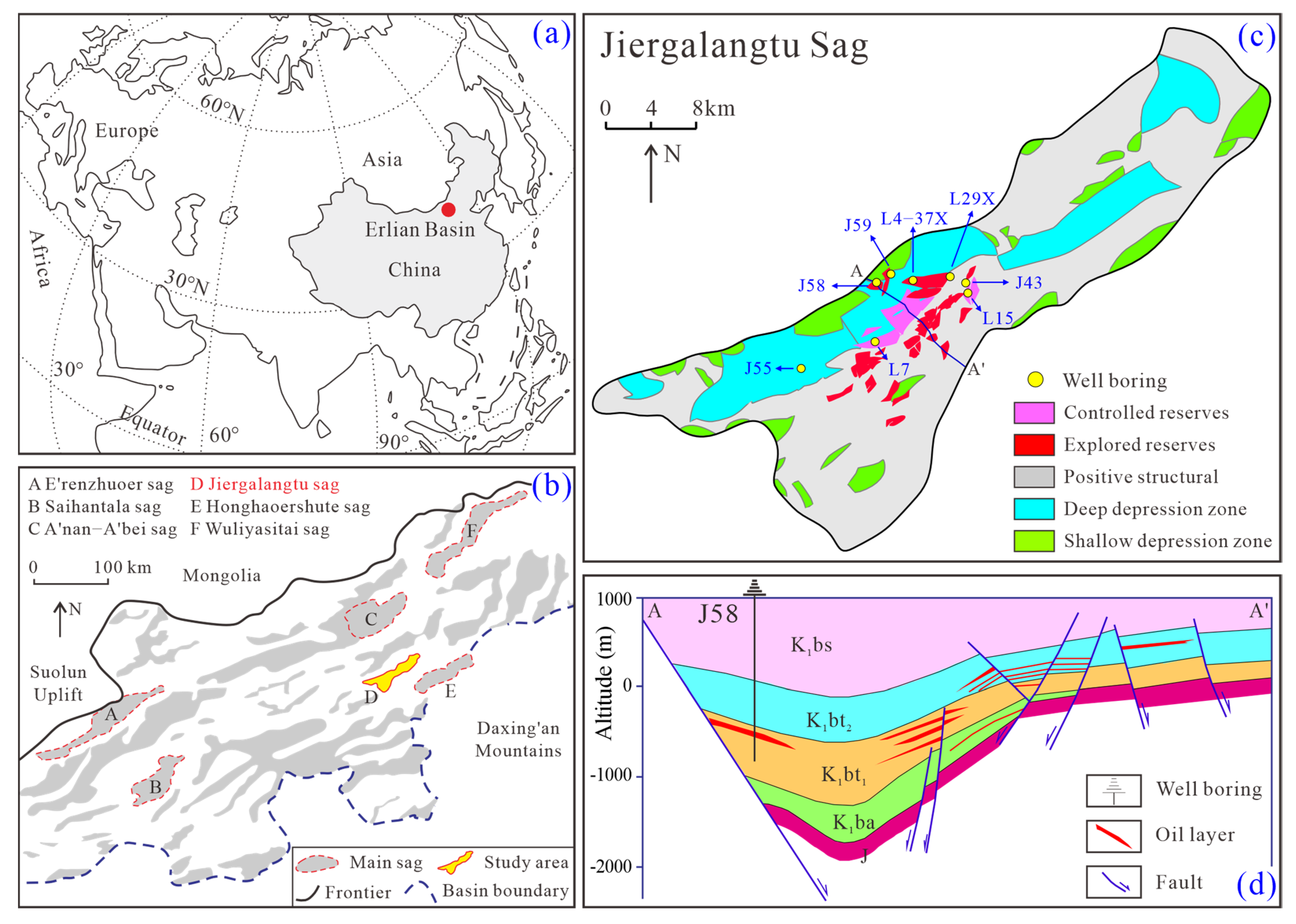





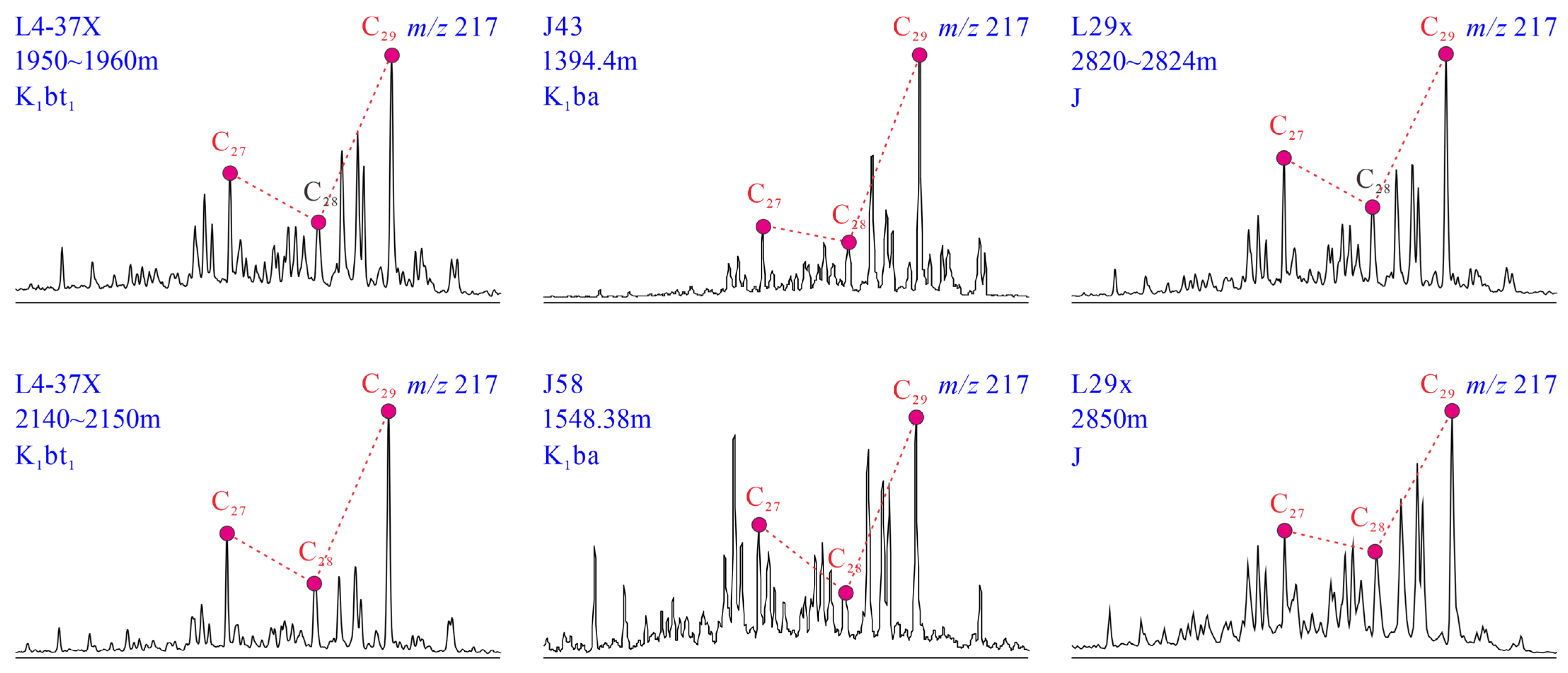



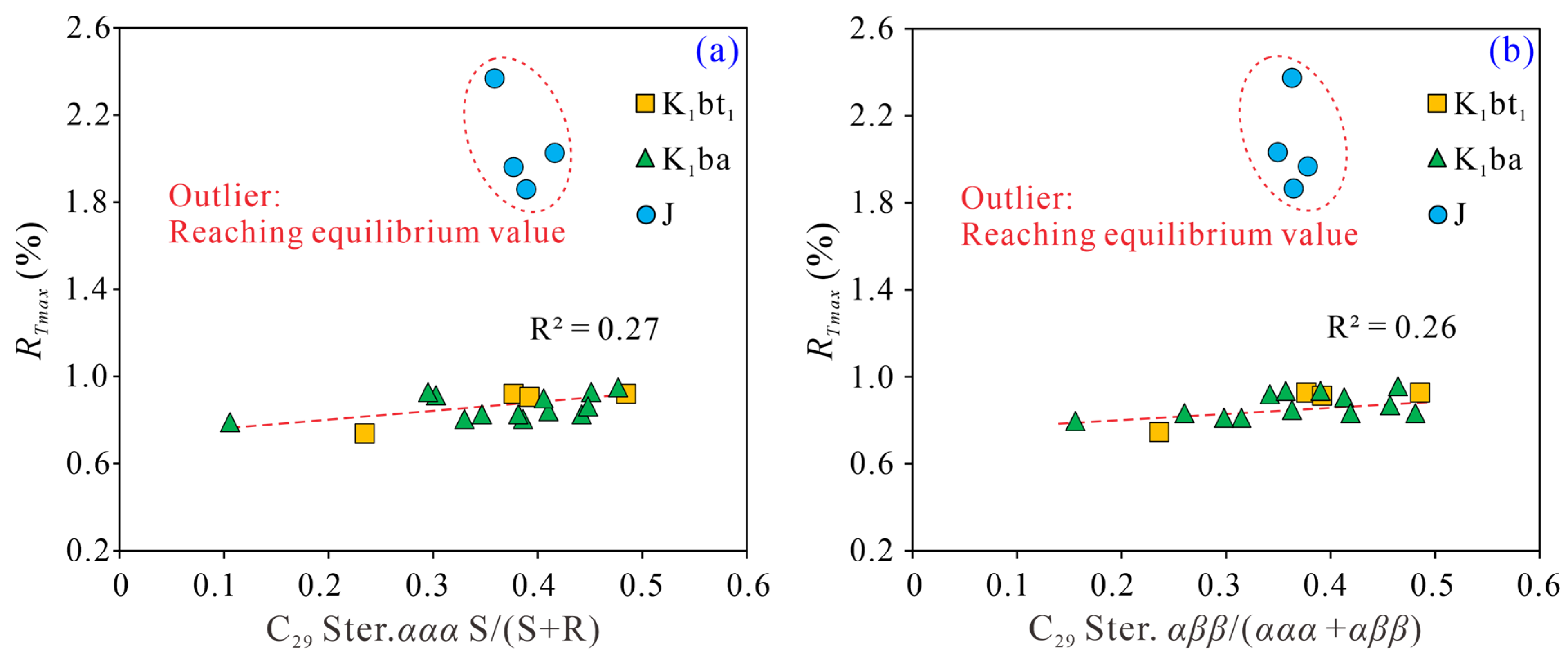

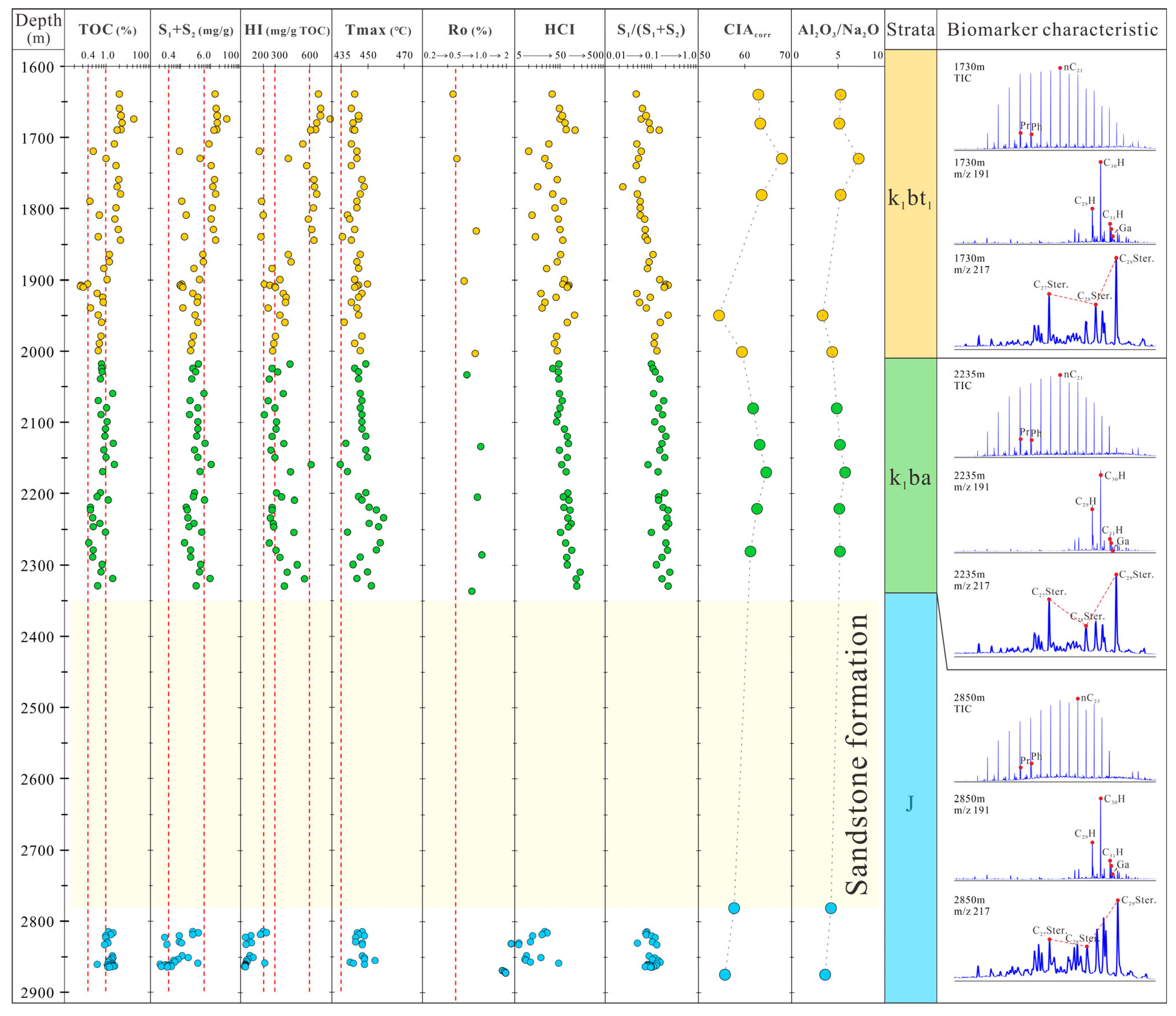

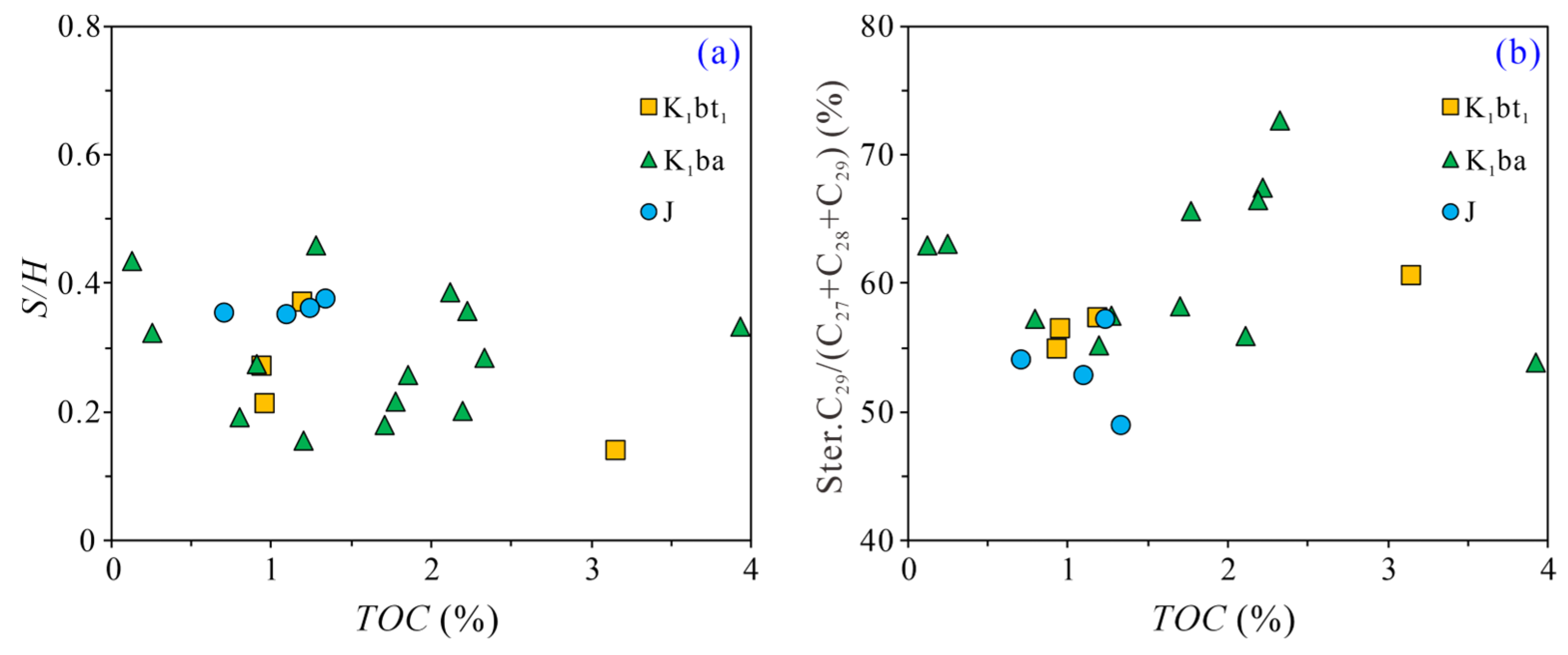

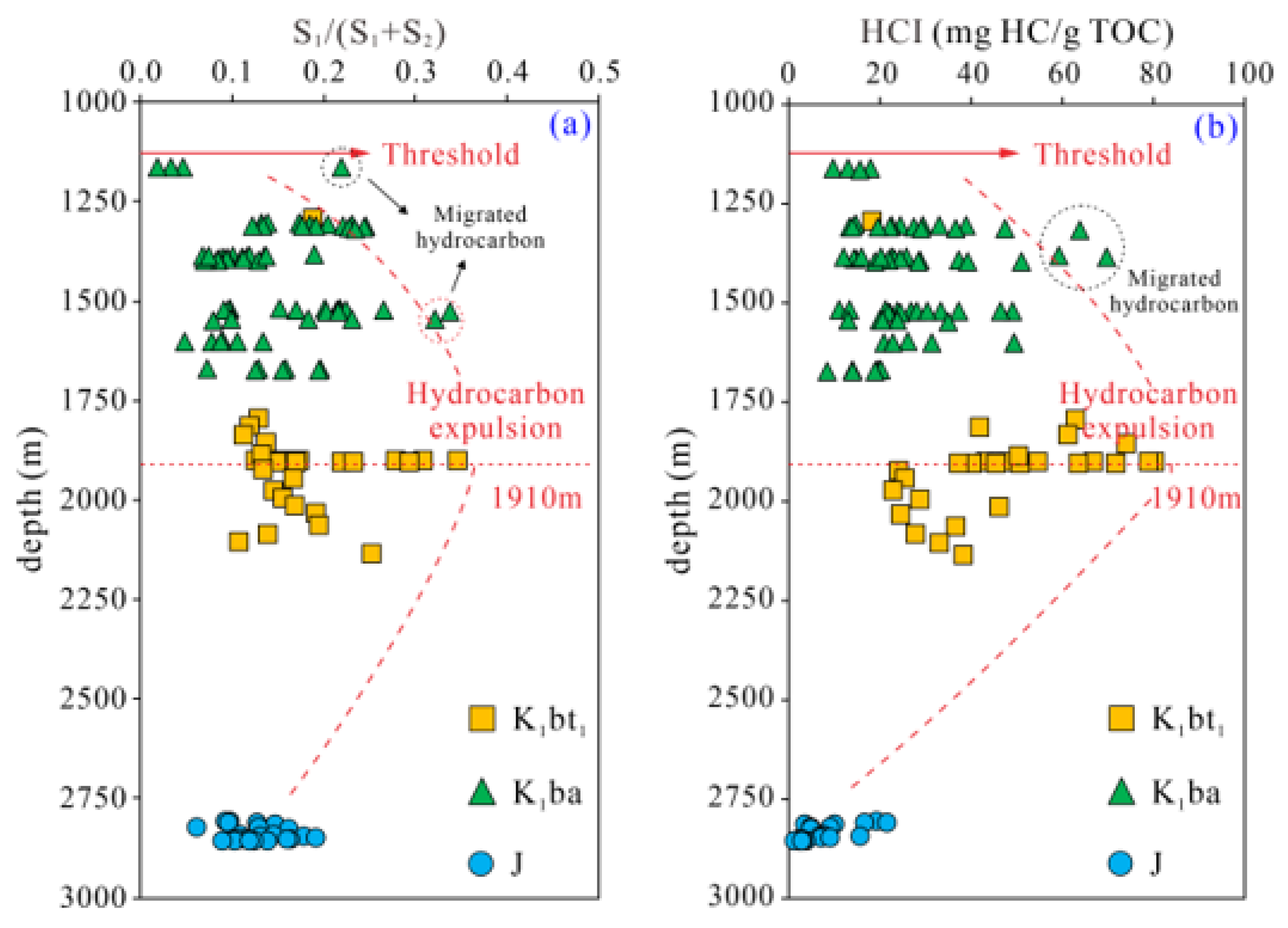

| Well | Strata | Depth (m) | Pr/Ph | Pr/nC17 | Ph/nC18 | OEP | C27 Ster. (%) | C29 Ster. (%) | C19+20 TT (%) | C21 TT (%) | C23 TT (%) | Ga/C30H | Ga/C31H | S/H | C35H/C31+32H |
|---|---|---|---|---|---|---|---|---|---|---|---|---|---|---|---|
| L4-37X | K1bt1 | 1860~1870 | 0.98 | 0.19 | 0.19 | 1.13 | 25.67 | 60.49 | 0.44 | 0.30 | 0.26 | 0.07 | 0.14 | 0.14 | 0.08 |
| L4-37X | K1bt1 | 1950~1960 | 1.07 | 0.22 | 0.23 | 1.08 | 27.66 | 56.43 | 0.45 | 0.29 | 0.27 | 0.10 | 0.21 | 0.21 | 0.19 |
| L4-37X | K1bt1 | 2040~2050 | 1.02 | 0.15 | 0.14 | 1.00 | 27.86 | 54.83 | 0.44 | 0.31 | 0.25 | 0.11 | 0.21 | 0.27 | 0.19 |
| L4-37X | K1bt1 | 2140~2150 | 1.00 | 0.12 | 0.13 | 1.03 | 27.24 | 57.25 | 0.48 | 0.37 | 0.15 | 0.13 | 0.27 | 0.37 | 0.24 |
| J43 | K1ba | 1390.58 | 0.64 | 0.52 | 0.89 | 1.20 | 14.96 | 71.68 | 0.43 | 0.27 | 0.30 | 0.44 | 2.28 | 0.28 | 0.22 |
| J43 | K1ba | 1394.4 | 0.55 | 0.63 | 1.22 | 1.21 | 18.76 | 67.45 | 0.40 | 0.26 | 0.35 | 0.10 | 0.42 | 0.36 | 0.24 |
| J43 | K1ba | 1400.2 | 0.57 | 0.51 | 0.98 | 1.19 | 15.31 | 72.64 | 0.38 | 0.28 | 0.34 | 0.11 | 0.50 | 0.28 | 0.18 |
| J55 | K1ba | 1306.8 | 1.40 | 0.37 | 0.26 | 1.02 | 25.17 | 57.48 | 0.46 | 0.28 | 0.26 | 0.17 | 0.39 | 0.46 | 0.49 |
| J55 | K1ba | 1315.34 | 1.45 | 0.46 | 0.31 | 1.01 | 26.63 | 55.94 | 0.40 | 0.27 | 0.33 | 0.12 | 0.33 | 0.39 | 0.33 |
| J58 | K1ba | 1520.75 | 1.08 | 0.28 | 0.21 | 1.02 | 22.20 | 63.10 | 0.42 | 0.26 | 0.31 | 0.15 | 0.30 | 0.32 | 0.30 |
| J58 | K1ba | 1523.55 | 0.88 | 0.28 | 0.28 | 1.08 | 28.81 | 55.26 | 0.40 | 0.32 | 0.28 | 0.20 | 0.61 | 0.16 | 0.42 |
| J58 | K1ba | 1527.6 | 0.99 | 0.28 | 0.30 | 1.01 | 21.70 | 62.98 | 0.46 | 0.31 | 0.22 | 0.21 | 0.50 | 0.44 | 0.48 |
| J58 | K1ba | 1548.38 | 1.12 | 0.40 | 0.32 | 1.13 | 30.16 | 57.28 | 0.44 | 0.29 | 0.26 | 0.23 | 0.64 | 0.19 | 0.41 |
| J58 | K1ba | 1602.26 | 0.79 | 0.22 | 0.27 | 1.03 | 17.03 | 66.52 | 0.41 | 0.33 | 0.26 | 0.28 | 0.89 | 0.20 | 0.30 |
| J58 | K1ba | 1603.76 | 0.75 | 0.22 | 0.29 | 1.06 | 18.86 | 65.62 | 0.41 | 0.34 | 0.25 | 0.20 | 0.65 | 0.22 | 0.27 |
| J59 | K1ba | 1166.01 | 0.59 | 0.64 | 1.19 | 1.24 | 28.88 | 53.87 | 0.40 | 0.35 | 0.26 | 0.25 | 1.53 | 0.33 | 0.29 |
| J7 | K1ba | 1673.06 | 1.08 | 0.17 | 0.18 | 1.17 | 26.71 | 58.27 | 0.34 | 0.29 | 0.38 | 0.12 | 0.44 | 0.18 | 0.34 |
| J15 | K1ba | 1388.25 | 1.50 | 0.64 | 0.43 | 1.23 | 52.98 | 38.53 | 0.50 | 0.22 | 0.27 | 0.11 | 0.28 | 0.26 | 0.29 |
| J29X | J | 2820~2824 | 0.89 | 0.23 | 0.22 | 0.96 | 29.85 | 52.72 | 0.39 | 0.28 | 0.33 | 0.10 | 0.24 | 0.35 | 0.24 |
| J29X | J | 2857.1 | 0.60 | 0.33 | 0.55 | 0.91 | 29.60 | 53.97 | 0.40 | 0.28 | 0.32 | 0.16 | 0.48 | 0.35 | 0.22 |
| J29X | J | 2858.95 | 0.61 | 0.18 | 0.29 | 0.98 | 32.98 | 48.93 | 0.35 | 0.26 | 0.39 | 0.15 | 0.37 | 0.37 | 0.26 |
| J29X | J | 2860.6 | 0.62 | 0.14 | 0.19 | 0.82 | 26.46 | 57.20 | 0.37 | 0.27 | 0.37 | 0.18 | 0.49 | 0.36 | 0.24 |
Disclaimer/Publisher’s Note: The statements, opinions and data contained in all publications are solely those of the individual author(s) and contributor(s) and not of MDPI and/or the editor(s). MDPI and/or the editor(s) disclaim responsibility for any injury to people or property resulting from any ideas, methods, instructions or products referred to in the content. |
© 2025 by the authors. Licensee MDPI, Basel, Switzerland. This article is an open access article distributed under the terms and conditions of the Creative Commons Attribution (CC BY) license (https://creativecommons.org/licenses/by/4.0/).
Share and Cite
Zhu, J.; Quan, Y.; Yan, R.; Xiang, X.; Xing, Y.; Hu, Y.; Shi, Y.; Li, H.; Yang, H.; Wu, J.; et al. Geochemical Characteristics and Hydrocarbon Generation Potential of Source Rock in the Baorao Trough, Jiergalangtu Sag, Erlian Basin. Minerals 2025, 15, 1002. https://doi.org/10.3390/min15091002
Zhu J, Quan Y, Yan R, Xiang X, Xing Y, Hu Y, Shi Y, Li H, Yang H, Wu J, et al. Geochemical Characteristics and Hydrocarbon Generation Potential of Source Rock in the Baorao Trough, Jiergalangtu Sag, Erlian Basin. Minerals. 2025; 15(9):1002. https://doi.org/10.3390/min15091002
Chicago/Turabian StyleZhu, Jieqiong, Yongbin Quan, Ruichang Yan, Xin Xiang, Yawen Xing, Yiming Hu, Yulei Shi, Hengrui Li, Huili Yang, Jianping Wu, and et al. 2025. "Geochemical Characteristics and Hydrocarbon Generation Potential of Source Rock in the Baorao Trough, Jiergalangtu Sag, Erlian Basin" Minerals 15, no. 9: 1002. https://doi.org/10.3390/min15091002
APA StyleZhu, J., Quan, Y., Yan, R., Xiang, X., Xing, Y., Hu, Y., Shi, Y., Li, H., Yang, H., Wu, J., Zhang, H., & Tian, N. (2025). Geochemical Characteristics and Hydrocarbon Generation Potential of Source Rock in the Baorao Trough, Jiergalangtu Sag, Erlian Basin. Minerals, 15(9), 1002. https://doi.org/10.3390/min15091002





